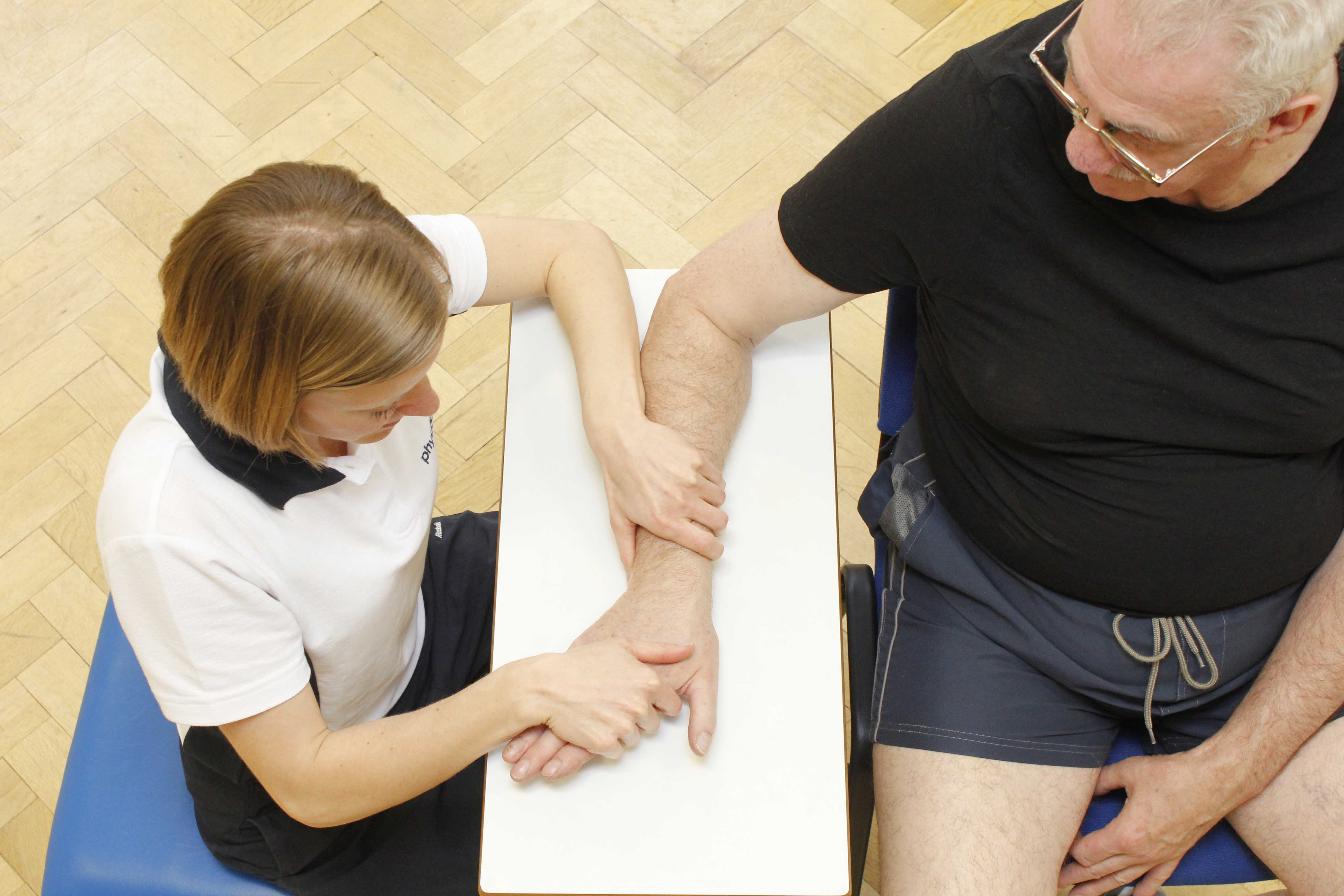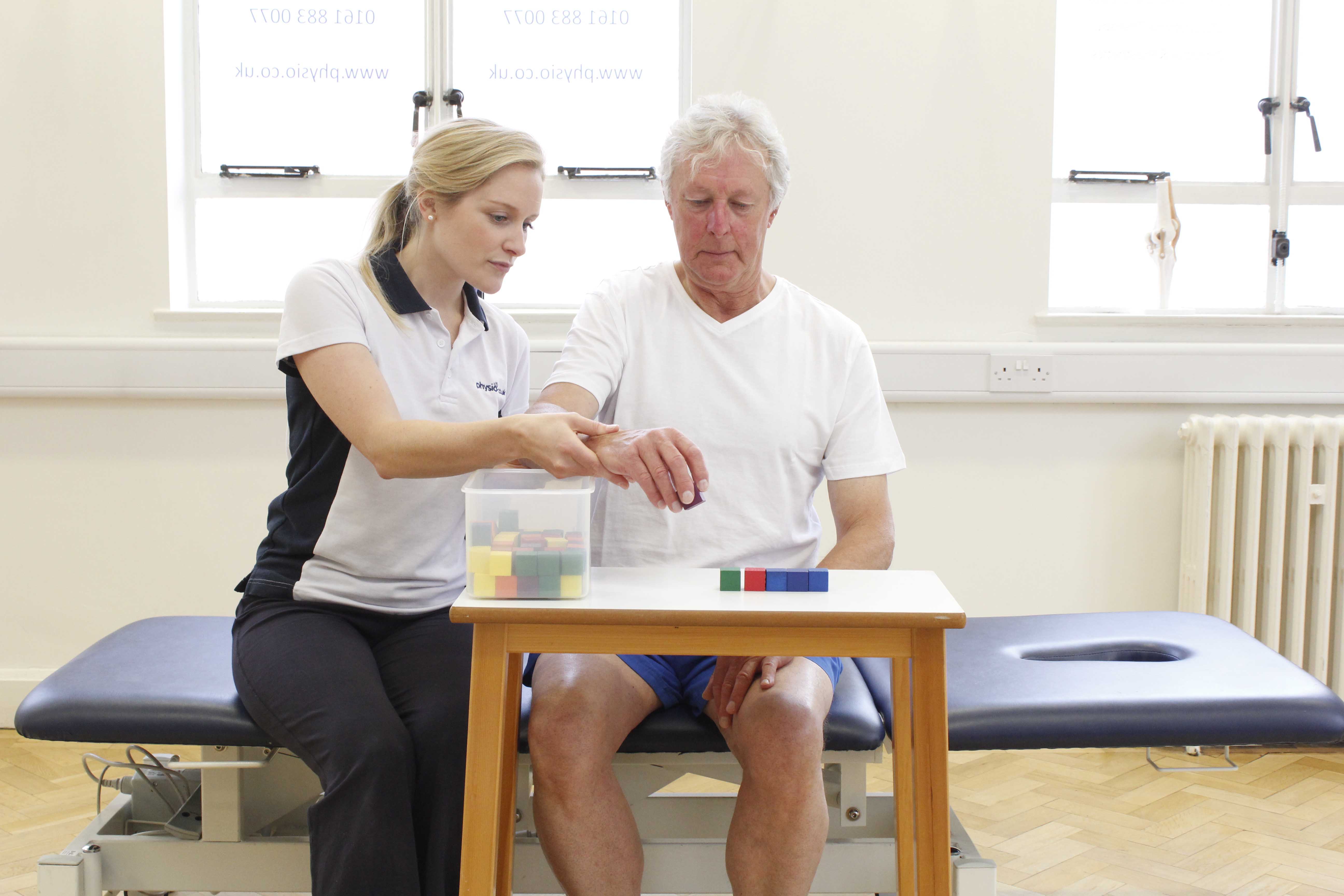- Scaphoid
- Triquetrum
- Lunate
- Pisiform
- Trapezium
- Traoezoid
- Hamate
- Capitate
 Above: Hand and wrist stretches and mobilisations by experienced MSK physiotherapist
Above: Hand and wrist stretches and mobilisations by experienced MSK physiotherapistThe carpal bones sit together and form numerous large and small joints. The ends of the bone are lined with smooth cartilage and are held together by multiple ligaments. The design and shape of the joints allow the wrist to bend and straighten, move side to side and twist the palm up or down. A fracture of one or more carpal bones can occur when there has been a large amount of force applied to the wrist, such as in the incidence of a fall onto an outstretched hand. Common symptoms of a wrist fracture include wrist pain, swelling and deformity of the wrist.
Treatment of carpal bone fractures depends on the severity of the injury. If the bones remain in their correct position the fracture can be treated with immobilisation in the form of a cast followed by a course of physiotherapy. If the fracture is slightly out of position (displaced) then the bones can be gently realigned under local anaesthesia and then immobilised. If the bones are severely displaced (out of position) then open surgery is required to realign the bones (open reduction) and then plates and screws may be used to hold the bones in their correct position (internal fixation) and facilitate effective healing. This procedure is called open reduction internal fixation (ORIF).
Carpal bone surgery is performed under general anaesthesia. During ORIF of the carpal bones, the surgeon makes an incision over the fracture site. The fractured bone is then realigned into its correct position (open reduction). The bone is then held in place using pins, screws, wires or a combination of each (internal fixation). The wound is then closed up using stitches or sutures. It is essential to undergo ORIF surgery of the wrist after suffering a displaced fracture as this will eliminate deformation, reduce pain, aid healing process and help return function in the wrist and hand.
Physiotherapy after surgery to the carpal bones is essentialto maximise the success of the surgery, prevent the likelihood of problems in the future and to help guarantee the return of full or near to full function in the wrist and hand after a wrist fracture.
 Above: Hand and wrist exercises supervised by MSK Physiotherapist
Above: Hand and wrist exercises supervised by MSK PhysiotherapistSymptoms after carpal bone surgery
Once you have undergone carpal bone surgery your wrist will be immobilised using a plaster of Paris cast or a splint for approximately 3 weeks. You will experience pain, swelling and stiffness in and around the wrist joint. You will be given pain killers and you’ll be advised to keep your wrist elevated above chest levels to minimise swelling. You may also be given a sling for support and protection in the early stages after your surgery. After your surgery you will experience some decrease in range of movement, mobility and function in your wrist joint. Physiotherapy should start as soon as possible once your cast or splint has been removed, although an intense physiotherapy programme will only begin once the fracture site has healed sufficiently.
Physiotherapy after carpal bone surgery
Physiotherapy is required as soon as possible after you carpal bone surgery to reduce pain, stiffness and swelling. Early physiotherapy also aids recovery by improving mobility, range of movement and strength in your affected wrist. A comprehensive physiotherapy programme with Physio.co.uk will help you achieve the return of full or near to full function in your wrist as well as preventing problems in the future that relate to your injury. Rehabilitation after carpal bone surgery may take up to 4 months. Physio.co.uk offers ongoing physiotherapy with goals that are personal to you and the problems you are experiencing. The goals of your rehabilitation may include:
- Restore a pain free wrist
- Restore full range of movement (ROM)
- Improve muscle strength
- Improve muscle flexibility
- Improve cardiovascular fitness and muscle endurance
- Re-establish function and independence
0-3 weeks
The main aims of your physiotherapy programme with Physio.co.uk during the first few weeks of rehabilitation will be to reduce pain and swelling that you will be experiencing at this time. Your physiotherapy will aim to gradually introduce your wrist back to gentle activity in the initial stages with a focus on maintaining range of movement and strength in your affected and non affected wrist. Your physiotherapy will include;
- Pain killers (to control pain)
- Elevation (to control swelling)
- Passive (assisted) range of movement exercises for affected arm (elbow and shoulder)
- Active (on your own)range of movement exercises for unaffected arm (wrist, hand, elbow and shoulder)
- Strengthening and range of movement exercises for unaffected arm
4-8 weeks
In the second stage of your physiotherapy course with Physio.co.uk, the goals of your physiotherapy will continue to focus on reducing any pain or swelling as well as increasing range of movement in your wrist. Once the fracture site of your affected carpal bones has healed sufficiently, your physiotherapy programme with Physio.co.uk can gear towards improving strength, flexibility and muscle control in and around your wrist joint. Your physiotherapy at this time will include;
- Continuation of modalities for pain and swelling
- Passive (assisted) and active (independent) range of movement exercises
- Gentle strengthening exercises (isometric – hold) for muscles of affected arm (pronator teres, supinator, wrist flexor muscles, wrist extensor muscles, hand and finger muscles)
- Passive (assisted) stretching exercises for muscles of affected arm Range of movement, strengthening and stretching exercises for unaffected arm
- Mobilisation of wrist joints
- Hand grip strengthening exercises
- Wrist, hand and elbow exercises
- Hydrotherapy
9-12 weeks
After two months of successful rehabilitation with Physio.co.uk, your physiotherapy will focus on the continuation and progression of activities from previous weeks. The goals of your therapy will be to minimise pain, improve range of movement as well as increase strength, endurance and muscle control of the muscles around your wrist joint. At this stage, your physiotherapy will begin to include more functional activities that are relevant to your job, hobbies and everyday life. Your therapy programme will include;
- Pain control
- Range of movement exercises for joints of hand, wrist and forearm
- Flexibility exercises
- Passive stretching (assisted) programme-with combined movement
- Strengthening exercises for muscles in affected and unaffected arm (pronator teres, supinator, wrist flexor muscles, wrist extensor muscles, hand and finger muscles)
- Mobilisation of wrist joints
- Hand grip strengthening exercises
- Hydrotherapy
- Arm cycle
3 months onwards
After three months of successful physiotherapy with Physio.co.uk your rehabilitation will concentrate on maximising strength and function in your wrist and hand. By this time, you should be experiencing minimal, if any, pain and swelling around your affected wrist. You will have seen marked improvements in the range of movement and strength in your affected wrist, hand and forearm.
The success of your recovery after carpal bone surgery will highly depend on the condition your wrist prior to the operation as well as your commitment to your physiotherapy programme with Physio.co.uk. Recovery may take 3 to 4 months.
Summary
Surgery of the carpal bones may be required to successfully treat a wrist fracture. A fracture to one or more of the carpal bones can occur as a result of a fall on an outstretched hand and can cause symptoms such as pain, swelling and deformity of the wrist. Fractures of the carpal bones can be non displaced (remains in position) or displaced (out of position). If the fracture is non displaced then a conservative approach using immobilisation followed by physiotherapy is appropriate. If the fracture is displaced the open reduction and internal fixation (ORIF) is required to realign the bone (open reduction) and then hold it in position (internal fixation) using screws or pins to aid healing. Physiotherapy after ORIF surgery of the carpal bones will maximise the success of the surgery, reduce pain and stiffness, aid the healing process and improve mobility and function in the wrist and hand. Physio.co.uk offers a personal physiotherapy programme that will help you achieve the return of full or near to full function in your arm whilst getting you back to your everyday activities, job, hobby or sport as soon as possible after your wrist fracture. Call Physio.co.uk now on 0330 088 7800 for more information or to book an appointment please contact us.

 0330 088 7800
0330 088 7800





































